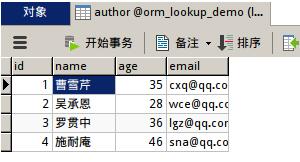如何用python 操作MongoDB數(shù)據(jù)庫
MongoDB屬于 NoSQL(非關(guān)系型數(shù)據(jù)庫),是一個基于分布式文件存儲的開源數(shù)據(jù)庫系統(tǒng)。
二、操作 MongoDB1、安裝 pymongopython 使用第三方庫來連接操作 MongoDB,所以我們首先安裝此庫。
pip3 install pymongodb
2、連接 MongoDB使用 MongoClient 類連接,以下兩種參數(shù)方式都可以:
from pymongo import MongoClient# 連接方式一client = MongoClient(host=’localhost’,port=27017)# 連接方式二# client = MongoClient(’mongodb://localhost:27017/’)3、選擇數(shù)據(jù)庫
MongoDB 可以創(chuàng)建很多 db,指定我們需要的 db 即可
# 方式一db = client.Monitor# 方式二# db = client[’Monitor’]4、選擇集合
db 內(nèi)包含很多個集合,有點(diǎn)類似 mysql 這類關(guān)系型數(shù)據(jù)庫中的表
# 方式一collection = db.test# 方式二# collection = db[’test’]5、插入數(shù)據(jù)
插入一條數(shù)據(jù),MongoDB 每條記錄都有一個唯一標(biāo)識。返回一個 InsertOneResult 對象,若需要獲取唯一標(biāo)識,找到 InsertOneResult 對象的屬性 inserted_id 即可
from pymongo import MongoClientclass mongodb: def __init__(self,host,db,port = 27017):’’’:param host: str mongodb地址:param db: str 數(shù)據(jù)庫:param port: int 端口,默認(rèn)為27017’’’host = hostdb = dbself.port = portclient = MongoClient(host=host,port=port)self.db = client[db] def insert_one(self,table,dic):’’’:param table: str 數(shù)據(jù)庫中的集合:param dic: dict 要插入的字典:return: 返回一個包含ObjectId類型的對象’’’collection = self.db[table]rep = collection.insert_one(dic)return repif __name__==’__main__’: dic = {’姓名’:’小明’,’English’:100,’math’:90} db = mongodb(host=’localhost’,db = ’test’) rep = db.insert_one(’test’,dic) print(rep.inserted_id)
插入多條數(shù)據(jù),使用 insert_many 批量插入
from pymongo import MongoClientclass mongodb: def __init__(self,host,db,port = 27017):’’’:param host: str mongodb地址:param db: str 數(shù)據(jù)庫:param port: int 端口,默認(rèn)為27017’’’host = hostdb = dbself.port = portclient = MongoClient(host=host,port=port)self.db = client[db] def insert_one(self,table,dic):’’’:param table: str 數(shù)據(jù)庫中的集合:param dic: dict 要插入的字典:return: 返回包含一個ObjectId類型的對象’’’collection = self.db[table]rep = collection.insert_one(dic)return rep def insert_many(self,table,lists):’’’:param table: str 數(shù)據(jù)庫中的集合:param dic: dict 要插入的列表,列表中的元素為字典:return: 返回包含多個ObjectId類型的列表對象’’’collection = self.db[table]rep = collection.insert_many(lists)return repif __name__==’__main__’: lists = [{’姓名’:’小明’,’English’:100,’math’:90}, {’姓名’:’小華’,’English’:90,’math’:100}] db = mongodb(host=’localhost’,db = ’test’) rep = db.insert_many(’test’,lists) for i in rep.inserted_ids:print(i)6、查詢
1)常規(guī)查詢
find_one :查詢單條記錄,返回一個字典。 find:查詢多條記錄 ,返回一個游標(biāo)對象。from pymongo import MongoClientclass mongodb: def __init__(self,host,db,port = 27017):’’’:param host: str mongodb地址:param db: str 數(shù)據(jù)庫:param port: int 端口,默認(rèn)為27017’’’host = hostdb = dbself.port = portclient = MongoClient(host=host,port=port)self.db = client[db] def find_one(self,table,dic):’’’:param table: str 數(shù)據(jù)庫中的集合:param dic: dict 查詢條件:return: dict 返回單條記錄的字典’’’collection = self.db[table]rep = collection.find_one(dic)return rep def find(self,table,dic):’’’:param table: str 數(shù)據(jù)庫中的集合:param dic: dict 查詢條件:return: list 返回查詢到記錄的列表’’’collection = self.db[table]rep = list(collection.find(dic))return repif __name__==’__main__’: # 查詢 English 成績?yōu)?100 的所有記錄 dic = {’English’:100} db = mongodb(host=’localhost’,db = ’test’) rep = db.insert_many(’test’,dic) print(rep)
2)范圍查詢
有時候我們需要范圍比較查詢,比如要查詢 English 成績?yōu)?80~90 ,可以使用比較符:dic = {’English’:{’$in’:[80,90]}}
$lt :小于 $lte:小于等于 $gt:大于 $gte:大于等于 $ne:不等于 $in:在范圍內(nèi) $nin:不在范圍內(nèi)3)計數(shù)
直接調(diào)用 count() 方法,返回一個 int 類型的數(shù)字
# 計數(shù)查詢只需要在普通查詢后加上 count() 即可count = collection.find().count() # count = collection.find({’English’:{’$gt’:90}}).count()
4)排序
排序時,直接調(diào)用sort()方法,并在其中傳入排序的字段及升降序標(biāo)志,返回一個游標(biāo)對象
# 正序 ASCENDING,倒序 DESCENDING。list()將游標(biāo)對象轉(zhuǎn)成列表data = list(collection.find(dic).sort(’姓名’,pymongo.DESCENDING))7、更新數(shù)據(jù)
首選查到需要更新的數(shù)據(jù),然后將該數(shù)據(jù)更新,返回一個 UpdataResult 對象, raw_result 屬性中包含 update 生效的個數(shù)。
update_one:更新查詢到的第一條數(shù)據(jù) update_many:更新多條數(shù)據(jù)from pymongo import MongoClientclass mongodb: def __init__(self,host,db,port = 27017):’’’:param host: str mongodb地址:param db: str 數(shù)據(jù)庫:param port: int 端口,默認(rèn)為27017’’’host = hostdb = dbself.port = portclient = MongoClient(host=host,port=port)self.db = client[db] def update_one(self,table,condition,dic):’’’:param table: str 數(shù)據(jù)庫中的集合:param condition: dict 查詢條件:param dic: dict 更新的數(shù)據(jù):return: 返回UpdateResult對象’’’collection = self.db[table]# $set 表示只更新dic字典內(nèi)存在的字段rep = collection.update_one(condition,{’$set’:dic})# 會把之前的數(shù)據(jù)全部用dic字典替換,如果原本存在其他字段,則會被刪除# rep = collection.update_one(condition, dic)return rep def update_many(self,table,condition,dic):’’’:param table: str 數(shù)據(jù)庫中的集合:param condition: dict 查詢條件:param dic: dict 更新的數(shù)據(jù):return:返回UpdateResult對象’’’collection = self.db[table]# $set 表示只更新dic字典內(nèi)存在的字段rep = collection.update_many(condition,{’$set’:dic})# 會把之前的數(shù)據(jù)全部用dic字典替換,如果原本存在其他字段,則會被刪除# rep = collection.update_many(condition, dic)return repif __name__==’__main__’: condition = {’English’:80} dic = {’English’:60} db = mongodb(host=’mongodb-monitor.monitor.svc.test.local’,db = ’test’) rep = db.update_one(’test’,condition,dic) print(rep.raw_result) # 輸出 {’n’: 1, ’nModified’: 1, ’ok’: 1.0, ’updatedExisting’: True}8、刪除
刪除和 update 類似,刪除數(shù)據(jù)后,返回一個 DeleteResult 對象, raw_result 屬性中包含 delete 的個數(shù)
delete_one:刪除查詢到的第一條數(shù)據(jù) delete_many:批量刪除符合查詢條件的數(shù)據(jù)from pymongo import MongoClientclass mongodb: def __init__(self,host,db,port = 27017):’’’:param host: str mongodb地址:param db: str 數(shù)據(jù)庫:param port: int 端口,默認(rèn)為27017’’’host = hostdb = dbself.port = portclient = MongoClient(host=host,port=port)self.db = client[db] def delete_one(self,table,dic):’’’:param table: str 數(shù)據(jù)庫中的集合:param dic: dict 查詢條件:return: 返回DeleteResult對象’’’collection = self.db[table]rep = collection.delete_one(dic)return rep def delete_many(self,table,dic):’’’:param table: str 數(shù)據(jù)庫中的集合:param dic: dict 查詢條件:return: 返回DeleteResult對象’’’collection = self.db[table]rep = collection.delete_many(dic)return repif __name__==’__main__’: dic = {’English’:60} db = mongodb(host=’localhost’,db = ’test’) rep = db.delete_many(’test’,dic) print(rep.raw_result) # 輸出 {’n’: 21, ’ok’: 1.0}
以上就是如何用python 操作MongoDB數(shù)據(jù)庫的詳細(xì)內(nèi)容,更多關(guān)于python 操作MongoDB數(shù)據(jù)庫的資料請關(guān)注好吧啦網(wǎng)其它相關(guān)文章!
相關(guān)文章:
1. React+umi+typeScript創(chuàng)建項目的過程2. .Net core 的熱插拔機(jī)制的深入探索及卸載問題求救指南3. ASP調(diào)用WebService轉(zhuǎn)化成JSON數(shù)據(jù),附j(luò)son.min.asp4. SharePoint Server 2019新特性介紹5. 三個不常見的 HTML5 實(shí)用新特性簡介6. 解決ASP中http狀態(tài)跳轉(zhuǎn)返回錯誤頁的問題7. ASP中常用的22個FSO文件操作函數(shù)整理8. 無線標(biāo)記語言(WML)基礎(chǔ)之WMLScript 基礎(chǔ)第1/2頁9. ASP.NET Core 5.0中的Host.CreateDefaultBuilder執(zhí)行過程解析10. ASP編碼必備的8條原則

 網(wǎng)公網(wǎng)安備
網(wǎng)公網(wǎng)安備